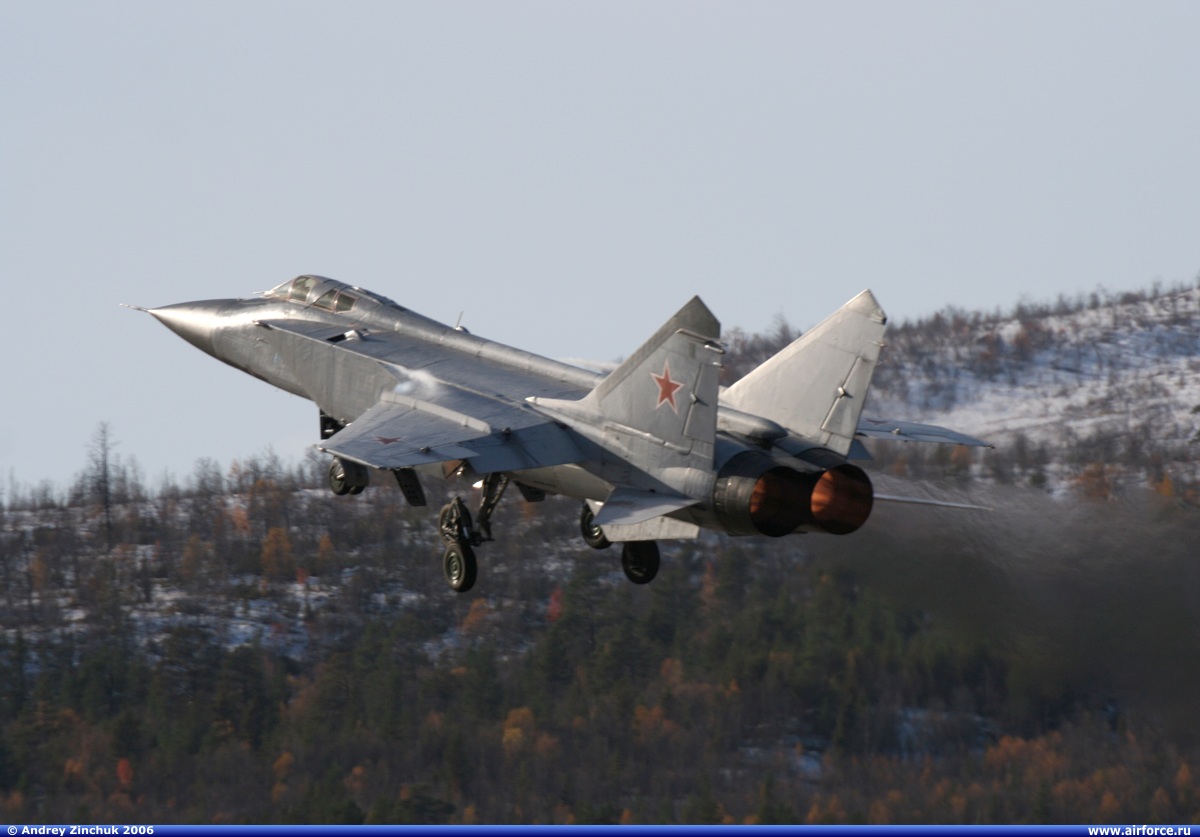Development of the MiG-25's replacement began with the Ye-155MP (Russian: ?-155??) prototype which first flew on 16 September 1975. Although it bore a superficial resemblance to a stretched MiG-25 with a longer fuselage for the radar operator cockpit, it was in many respects a new design. The MiG-25 used 80% nickel steel in its structure to allow welding. The Ye-155MP doubled the use of titanium to 16% and tripled the aluminium content to 33% to reduce structural mass. More importantly, supersonic speed was now possible at low altitudes. Fuel capacity was also increased, and new, more efficient low bypass ratio turbofan engines were fitted.
The most important development was introducing an advanced radar capable of both look-up and look-down engagement (locating targets above and below the aircraft), as well as multiple target tracking. This finally gave the Soviets an interceptor able to engage the most likely Western intruders at long range. It also reflected a policy shift from reliance on ground-controlled interception (GCI) to greater autonomy for flight crews.
Like its MiG-25 predecessor, the MiG-31 was surrounded by early speculation and misinformation concerning its design and abilities. The West learned of the new interceptor from Lieutenant Viktor Belenko, a pilot who defected to Japan in 1976 with his MiG-25P. Belenko described an upcoming "Super Foxbat" with two seats and an ability to intercept cruise missiles. According to his testimony, the new interceptor was to have air intakes similar to the Mikoyan-Gurevich MiG-23, which the MiG-31 does not have, at least not in production variants. While the MiG-31 was undergoing testing, an unknown aircraft was spotted by a reconnaissance satellite at the Zhukovsky flight test center near the town of Ramenskoye. The images were interpreted as a fixed-wing interceptor version of a swing-wing fighter codenamed "Ram-K". The latter was eventually revealed to be the Sukhoi Su-27 'Flanker', a wholly unrelated design.
Series production of the MiG-31 began in 1979 and about 500 were produced.
Some upgrade programs have found their way in the MiG-31 fleet, like the MiG-31BM multirole version with upgraded avionics, new multimode radar, hands-on-throttle-and-stick (HOTAS) controls, liquid crystal (LCD) color multi-function displays (MFDs), ability to carry the AA-12 'Adder' missile and various Russian air-to-ground missiles (AGMs) such as the AS-17 'Krypton' anti-radiation missile (ARM), a new and more powerful computer, and digital data links. A project to upgrade the Russian MiG-31 fleet to the MiG-31BM standard is nearing completion.
General characteristics
- Crew: Two (pilot and weapons system officer)
- Length: 22.69 m (74 ft 5 in)
- Wingspan: 13.46 m (44 ft 2 in)
- Height: 6.15 m (20 ft 2 in)
- Wing area: 61.6 m² (663 ft²)
- Empty weight: 21,820 kg (48,100 lb)
- Loaded weight: 41,000 kg (90,400 lb)
- Max takeoff weight: 46,200 kg (101,900 lb)
- Powerplant: 2 × Soloviev D-30F6 afterburning turbofans
- Dry thrust: 93 kN (20,900 lbf) each
- Thrust with afterburner: 152 kN (34,172 lbf) each
- Maximum speed:
- Combat radius: 720 km (450 mi) at Mach 2.35
- Ferry range: 3,300 km (2,050 mi)
- Service ceiling: 20,600 m (67,600 ft)
- Rate of climb: 208 m/s (41,000 ft/min)
- Wing loading: 665 kg/m² (136 lb/ft²)
- Thrust/weight: 0.85
- Maximum g-load: 5 g
- 1× GSh-6-23 23 mm cannon with 260 rounds.
- Fuselage recesses for 4× R-33 (AA-9 'Amos') (or for MiG-31M/BM only 6× R-37 (AA-X-13 'Arrow') long-range air-to-air missiles)
- 4 underwing pylons for a combination of:
- 2× R-40TD1 (AA-6 'Acrid') medium-range missiles, and
- 4× R-60 (AA-8 'Aphid') or
- 4× R-73 (AA-11 'Archer') short-range IR missiles, or
- 4× R-77 (AA-12 'Adder') medium-range missiles.
- Some aircraft are equipped to launch the Kh-31P (AS-17 'Krypton') and Kh-58 (AS-11 'Kilter') anti-radiation missiles in the suppression of enemy air defenses (SEAD) role.
